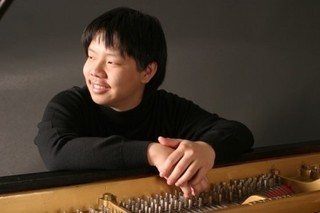|
Back
A Most MaRavelous Touch New York
SubCulture, 45 Bleeker Street
01/08/2015 -
New York International Piano Competition
Horatio Parker: Trois Morceaux characteristiques: La Sauterelle, Op. 49, No.2
Charles Ives: Piano Sonata No. 1
Maurice Ravel: Sonatine – Miroirs
Larry Weng (Pianist)

L.Weng (© Subculture)
Still in his 20’s, Larry Weng has won more than his fair share of prizes, so he had the audacity (and obvious confidence) to devote three-quarters of his recital in SubCulture to works almost never performed in New York.
A laureate of the Boston Symphony Orchestra’s Concerto Competition, the Tchaikovsky International Piano Competition for young Musicians and the New York International Piano Competition–amongst other prizes–Mr. Weng is also a graduate of Yale University, so it was befitting that the two opening works were devoted to composers of his alma mater.
The first, by Yale Professor Horatio Parker, a composer never heard in concert halls these days (though his liturgical music is perchance played in churches). Charles Ives, his erstwhile student, didn’t think much of him, but probably learned enough theory from Parker. What we learned last night was that he could write a charming bagatelle about a grasshopper, and the awkward grasshopper-hopping was perhaps considered quite modern in the 1880’s.
But the major Yale work here was the rarely played Ives First Sonata, which–in effects–is far more difficult than the “Concord”. The latter was a tone-poem of sorts, so a pianist who can master the technical challenges may pretend to offer us Emerson, Thoreau, and a quaint Alcott family. Not so with this equally dissonant First Sonata, whose difficulties, amorphous transpositions and fleeting lapses into familiar melodies can seem much of a blur.
I had never heard this live before, but Jeremy Denk’s recent recording make the work sound all too easy. Mr. Denk also had the advantage of electronics, so the hymn-tunes in each movement could stand out from the pianistic smudges.
Larry Weng certainly was expert on getting those notes right, and his performance of the 30-minute work was worthy of the greatest respect. Yet the acoustics of SubCulture are unable to bring forth the underlying songs, and the resonances conceal the arcane languages of Ives composition. With the piano wide open, with a maximum use of the pedal, Mr.Weng played an Ives which rang loudly and triumphantly from start to finish. Yet very little soul be found underneath the notes.
Whatever one was expecting in the second half, nobody–and certainly not this listener–expected the unbelievably sensitive, fascinating and keyboard-perfect Ravel performed here.
The opening Sonatine, hides its secrets under an 18th Century glittering veneer. Mr. Weng eschewed the jewels, though, to give us an Age of Reason simplicity in the first two movements, and a blazing finale. Here, in fact, he displayed his most singular touch of genius, which was...well, touch itself. Each note of each filigree had its own character, and with little use of pedal, he offered almost (though hardly consciously) the kind of plucking from a harpsichord or spinet of that time.
The truly astonishing work last evening was the complete Ravel Miroirs. The rarity is that most pianists dare not play all five pieces in one go–and Mr. Weng’s frequent use of the handkerchief to wipe his brow was easily forgiven.
This was more than an immaculate performance. Mr. Weng may lack the easy-going Gallic nonchalance of French artists, but we had a unique power in Mr. Weng’s touch. Every key was heard, the fastest passages were not simple runs, but the exercise of each note in its place.
The “night moths” of Noctuelles were played with the greatest precision up to the final measures. That always tricky Une barque sur l’océan wasn’t played to give mal de mer, but to give us the voyage of a Japanese etching, each “wave” a singular occurrence. And in La Vallée des cloches, Mr. Weng weighed each chord. While he hadn’t succeeded in unveiling the secret melodies of the Ives, he gave us time to hear even the most fragile nuanced resonance of the bells.
For the dizzying Alborada del gracioso, the verve, the brilliance was absolutely radiant. Radiant and transparent, picturesque and picaresqiue, wild but with the artistic perfection of wildness. SubCulture audience are not the kind who interrupt a work with applause, but the applause after this penultimate movement was inevitable and heartfelt and well deserved.
Harry Rolnick
|